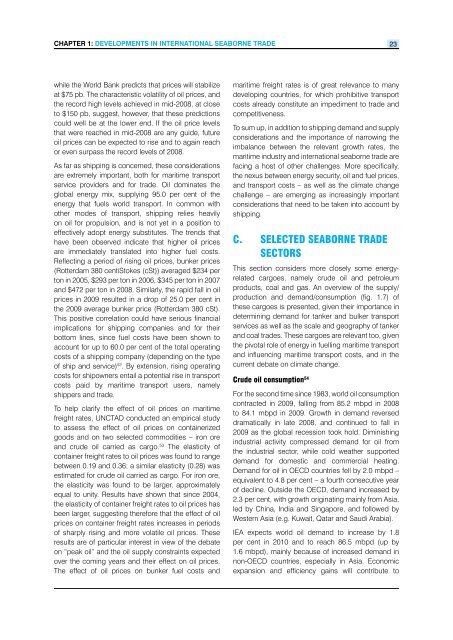Review of Maritime Transport 2010 - Unctad
Review of Maritime Transport 2010 - Unctad
Review of Maritime Transport 2010 - Unctad
Create successful ePaper yourself
Turn your PDF publications into a flip-book with our unique Google optimized e-Paper software.
CHapteR 1: DeveLopMents in inteRnationaL seaBoRne tRaDe 23<br />
while the World Bank predicts that prices will stabilize<br />
at $75 pb. The characteristic volatility <strong>of</strong> oil prices, and<br />
the record high levels achieved in mid-2008, at close<br />
to $150 pb, suggest, however, that these predictions<br />
could well be at the lower end. If the oil price levels<br />
that were reached in mid-2008 are any guide, future<br />
oil prices can be expected to rise and to again reach<br />
or even surpass the record levels <strong>of</strong> 2008.<br />
As far as shipping is concerned, these considerations<br />
are extremely important, both for maritime transport<br />
service providers and for trade. Oil dominates the<br />
global energy mix, supplying 95.0 per cent <strong>of</strong> the<br />
energy that fuels world transport. In common with<br />
other modes <strong>of</strong> transport, shipping relies heavily<br />
on oil for propulsion, and is not yet in a position to<br />
effectively adopt energy substitutes. The trends that<br />
have been observed indicate that higher oil prices<br />
are immediately translated into higher fuel costs.<br />
Reflecting a period <strong>of</strong> rising oil prices, bunker prices<br />
(Rotterdam 380 centiStokes (cSt)) averaged $234 per<br />
ton in 2005, $293 per ton in 2006, $345 per ton in 2007<br />
and $472 per ton in 2008. Similarly, the rapid fall in oil<br />
prices in 2009 resulted in a drop <strong>of</strong> 25.0 per cent in<br />
the 2009 average bunker price (Rotterdam 380 cSt).<br />
This positive correlation could have serious financial<br />
implications for shipping companies and for their<br />
bottom lines, since fuel costs have been shown to<br />
account for up to 60.0 per cent <strong>of</strong> the total operating<br />
costs <strong>of</strong> a shipping company (depending on the type<br />
<strong>of</strong> ship and service) 52 . By extension, rising operating<br />
costs for shipowners entail a potential rise in transport<br />
costs paid by maritime transport users, namely<br />
shippers and trade.<br />
To help clarify the effect <strong>of</strong> oil prices on maritime<br />
freight rates, UNCTAD conducted an empirical study<br />
to assess the effect <strong>of</strong> oil prices on containerized<br />
goods and on two selected commodities – iron ore<br />
and crude oil carried as cargo. 53 The elasticity <strong>of</strong><br />
container freight rates to oil prices was found to range<br />
between 0.19 and 0.36; a similar elasticity (0.28) was<br />
estimated for crude oil carried as cargo. For iron ore,<br />
the elasticity was found to be larger, approximately<br />
equal to unity. Results have shown that since 2004,<br />
the elasticity <strong>of</strong> container freight rates to oil prices has<br />
been larger, suggesting therefore that the effect <strong>of</strong> oil<br />
prices on container freight rates increases in periods<br />
<strong>of</strong> sharply rising and more volatile oil prices. These<br />
results are <strong>of</strong> particular interest in view <strong>of</strong> the debate<br />
on “peak oil” and the oil supply constraints expected<br />
over the coming years and their effect on oil prices.<br />
The effect <strong>of</strong> oil prices on bunker fuel costs and<br />
maritime freight rates is <strong>of</strong> great relevance to many<br />
developing countries, for which prohibitive transport<br />
costs already constitute an impediment to trade and<br />
competitiveness.<br />
To sum up, in addition to shipping demand and supply<br />
considerations and the importance <strong>of</strong> narrowing the<br />
imbalance between the relevant growth rates, the<br />
maritime industry and international seaborne trade are<br />
facing a host <strong>of</strong> other challenges. More specifically,<br />
the nexus between energy security, oil and fuel prices,<br />
and transport costs – as well as the climate change<br />
challenge – are emerging as increasingly important<br />
considerations that need to be taken into account by<br />
shipping.<br />
c. Selected SeABorne trAde<br />
SectorS<br />
This section considers more closely some energyrelated<br />
cargoes, namely crude oil and petroleum<br />
products, coal and gas. An overview <strong>of</strong> the supply/<br />
production and demand/consumption (fig. 1.7) <strong>of</strong><br />
these cargoes is presented, given their importance in<br />
determining demand for tanker and bulker transport<br />
services as well as the scale and geography <strong>of</strong> tanker<br />
and coal trades. These cargoes are relevant too, given<br />
the pivotal role <strong>of</strong> energy in fuelling maritime transport<br />
and influencing maritime transport costs, and in the<br />
current debate on climate change.<br />
crude oil consumption 54<br />
For the second time since 1983, world oil consumption<br />
contracted in 2009, falling from 85.2 mbpd in 2008<br />
to 84.1 mbpd in 2009. Growth in demand reversed<br />
dramatically in late 2008, and continued to fall in<br />
2009 as the global recession took hold. Diminishing<br />
industrial activity compressed demand for oil from<br />
the industrial sector, while cold weather supported<br />
demand for domestic and commercial heating.<br />
Demand for oil in OECD countries fell by 2.0 mbpd –<br />
equivalent to 4.8 per cent – a fourth consecutive year<br />
<strong>of</strong> decline. Outside the OECD, demand increased by<br />
2.3 per cent, with growth originating mainly from Asia,<br />
led by China, India and Singapore, and followed by<br />
Western Asia (e.g. Kuwait, Qatar and Saudi Arabia).<br />
IEA expects world oil demand to increase by 1.8<br />
per cent in <strong>2010</strong> and to reach 86.5 mbpd (up by<br />
1.6 mbpd), mainly because <strong>of</strong> increased demand in<br />
non-OECD countries, especially in Asia. Economic<br />
expansion and efficiency gains will contribute to

















